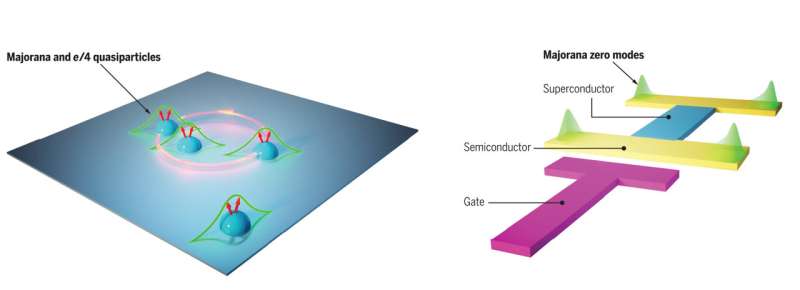This article has been reviewed according to Science X's editorial process and policies. Editors have highlighted the following attributes while ensuring the content's credibility:
fact-checked
peer-reviewed publication
trusted source
proofread
Quantum experts review major techniques for isolating Majoranas

Named after an Italian theoretical physicist, Majoranas are complex quasiparticles that could be the key to building next-generation quantum computing systems.
Most materials contain many electrons, each of which has a negative charge and a type of intrinsic quantum momentum known as spin. Interactions between electrons in some materials can produce emergent particles, or particles that have entirely different characteristics from the electrons that comprise them. Examples include materials in which spin and charge part ways and materials in which the unit of charge breaks down into smaller fractions.
Majoranas, which fall into this category of emergent particles, can exist in certain types of superconductors and in a quantum state of matter known as a spin liquid. Two Majoranas combine to form an electron, so scientists aim to identify materials in which these Majoranas can exist separately. Doing so would enable researchers to observe the unique capabilities that these particles demonstrate on their own—including efficient methods for storing and transferring information across great distances.
In pursuit of this goal, a team of researchers that includes Harvard University's Amir Yacoby, a member of the Quantum Science Center headquartered at the Department of Energy's Oak Ridge National Laboratory, has published a review paper in Science on the state of the field of Majorana research. The QSC is a DOE National Quantum Information Science Research Center.
The team, comprising researchers from Harvard, Princeton University and the Free University of Berlin, is focused on studying Majorana behavior to bolster knowledge of these particles' potential applications and of their impact on fundamental scientific phenomena.
"These peculiar particles only exist in certain materials," Yacoby said. "So, the questions are, in which materials do they exist and how? And what kinds of tests can we do to determine whether a particular material has the potential to host Majoranas? Answering these questions is one of the main challenges in this field."
In their paper, the researchers describe progress made over the past decade and primarily focus on the four platforms that show promise for isolating and measuring Majoranas—nanowires, the fractional quantum Hall effect, topological materials and Josephson junctions.
Nanowires, which are the most studied option for realizing Majorana-based quantum systems, are thin rods made of a semiconducting material. Another way to create an atmosphere hospitable to Majoranas is to enable the fractional quantum Hall effect, which occurs when electrons move in a plane subject to a strong magnetic field.
Many topological materials are also potential hosts for Majoranas because of their seemingly contradictory structure of interior regions that act as electrical insulators and exterior regions that easily conduct electricity. Finally, Josephson junctions consist of two superconductors separated by a normal piece of metal or a semiconductor. Previous QSC studies have indicated that these superconductor sandwiches could be engineered to comfortably house Majoranas.
"When we apply new techniques to these different types of materials, what often happens is we discover things we didn't expect," Yacoby said. "Part of our goal is to better understand what exactly we're seeing in the signatures we observe."
This research aligns with QSC priorities. The researchers are working with other QSC members, including Prineha Narang at UCLA and Stephen Jesse at ORNL, to continue devising new theoretical and experimental methodologies aimed at screening materials for Majoranas.
"Through the QSC, we've been able to take advantage of new technologies that are emerging within the quantum science community," Yacoby said. "These include new ways of measuring and probing matter to devise new tests that will tell us whether a material is worth considering as a possible host for Majoranas or not."
More information: Ali Yazdani et al, Hunting for Majoranas, Science (2023). DOI: 10.1126/science.ade0850
Journal information: Science
Provided by Oak Ridge National Laboratory





















